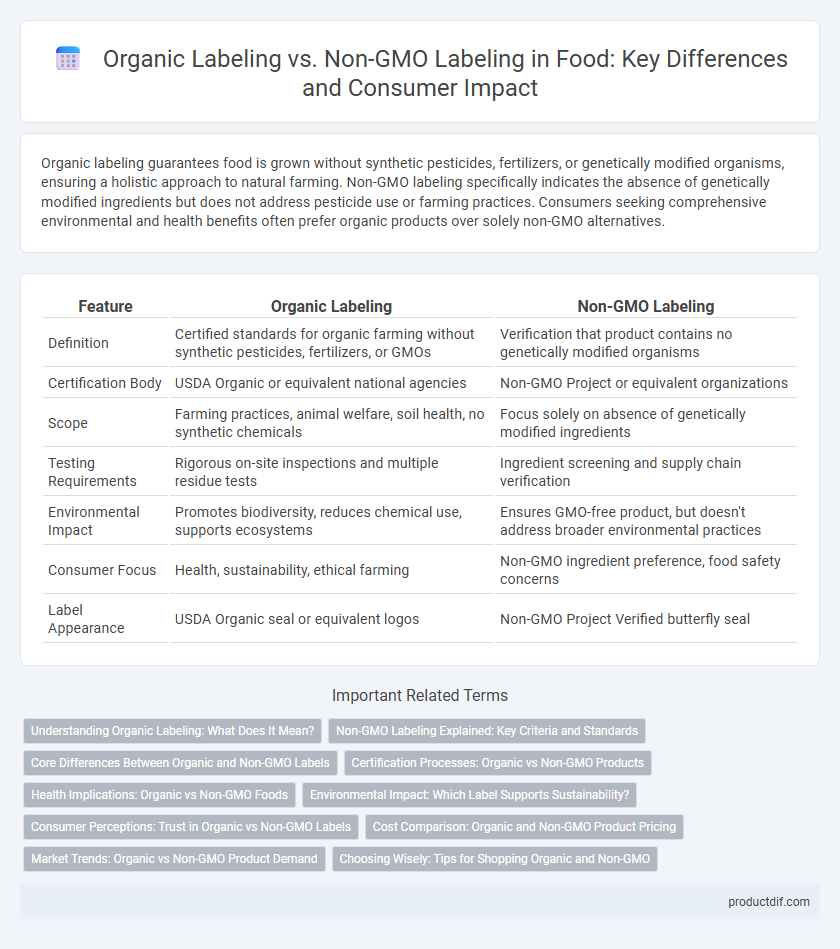Organic labeling guarantees food is grown without synthetic pesticides, fertilizers, or genetically modified organisms, ensuring a holistic approach to natural farming. Non-GMO labeling specifically indicates the absence of genetically modified ingredients but does not address pesticide use or farming practices. Consumers seeking comprehensive environmental and health benefits often prefer organic products over solely non-GMO alternatives.
Table of Comparison
| Feature | Organic Labeling | Non-GMO Labeling |
|---|---|---|
| Definition | Certified standards for organic farming without synthetic pesticides, fertilizers, or GMOs | Verification that product contains no genetically modified organisms |
| Certification Body | USDA Organic or equivalent national agencies | Non-GMO Project or equivalent organizations |
| Scope | Farming practices, animal welfare, soil health, no synthetic chemicals | Focus solely on absence of genetically modified ingredients |
| Testing Requirements | Rigorous on-site inspections and multiple residue tests | Ingredient screening and supply chain verification |
| Environmental Impact | Promotes biodiversity, reduces chemical use, supports ecosystems | Ensures GMO-free product, but doesn't address broader environmental practices |
| Consumer Focus | Health, sustainability, ethical farming | Non-GMO ingredient preference, food safety concerns |
| Label Appearance | USDA Organic seal or equivalent logos | Non-GMO Project Verified butterfly seal |
Understanding Organic Labeling: What Does It Mean?
Organic labeling indicates that food products are grown without synthetic pesticides, fertilizers, genetically modified organisms (GMOs), or irradiation, and are certified by authorized agencies such as USDA Organic. This certification ensures adherence to strict agricultural practices promoting environmental sustainability and animal welfare. Unlike non-GMO labeling, which only confirms the absence of genetically modified ingredients, organic labeling encompasses a broader range of health and ecological standards.
Non-GMO Labeling Explained: Key Criteria and Standards
Non-GMO labeling certifies products as free from genetically modified organisms, adhering to strict standards set by organizations like the Non-GMO Project. This certification involves rigorous testing and traceability requirements to ensure ingredients meet non-GMO criteria across the supply chain. Unlike organic labels, which cover broader farming practices, non-GMO labels specifically target the exclusion of genetically engineered ingredients in food products.
Core Differences Between Organic and Non-GMO Labels
Organic labeling certifies that food products are grown without synthetic pesticides, fertilizers, or genetically modified organisms, adhering to strict USDA Organic standards focused on sustainable farming practices. Non-GMO labeling specifically indicates that the product does not contain genetically modified organisms but does not regulate pesticide use or farming methods as comprehensively as organic certification. While organic labels encompass a broader scope of environmental and health criteria, Non-GMO labels target only the genetic modification aspect, making the core difference their range of regulations and sustainability requirements.
Certification Processes: Organic vs Non-GMO Products
Organic labeling requires certification through USDA Organic standards involving comprehensive soil health, pest management, and synthetic input restrictions audits, while Non-GMO labeling, often verified by organizations such as the Non-GMO Project, focuses primarily on the genetic makeup of the product, ensuring no genetically modified organisms are present. The organic certification process demands rigorous farm inspections and ongoing compliance with detailed organic farming practices, whereas Non-GMO verification emphasizes testing and traceability to prevent GMO contamination. Both certifications enhance consumer trust but differ fundamentally in scope--organic certification covers broader agricultural methods, whereas Non-GMO certification specifically targets genetic modifications.
Health Implications: Organic vs Non-GMO Foods
Organic foods often contain fewer pesticides and no synthetic fertilizers, which may reduce exposure to harmful chemicals and benefit overall health. Non-GMO labeling ensures that the food does not contain genetically modified organisms but does not guarantee the absence of pesticides or synthetic additives. Research suggests organic products may offer higher antioxidant levels and lower pesticide residues compared to non-GMO foods, potentially supporting better long-term health outcomes.
Environmental Impact: Which Label Supports Sustainability?
Organic labeling promotes sustainability by prohibiting synthetic pesticides and fertilizers, enhancing soil health, and supporting biodiversity, thus reducing environmental degradation. Non-GMO labeling solely indicates the absence of genetically modified organisms without addressing farming practices or chemical use, offering limited environmental benefits. Choosing organic-certified products fosters eco-friendly agriculture and long-term environmental resilience.
Consumer Perceptions: Trust in Organic vs Non-GMO Labels
Consumers generally perceive organic labels as more trustworthy due to stringent certification processes and broader environmental standards, whereas non-GMO labels focus primarily on the absence of genetically modified organisms. Surveys indicate that organic labeling evokes a stronger association with health benefits and sustainability, influencing purchasing decisions more significantly than non-GMO labeling alone. Trust in organic labels is bolstered by regulatory oversight from recognized bodies like USDA Organic, while non-GMO labels often rely on third-party verification that may vary in rigor.
Cost Comparison: Organic and Non-GMO Product Pricing
Organic products typically carry higher price tags due to stricter certification processes and more labor-intensive farming practices, often costing 20-40% more than conventional options. Non-GMO labeled products generally incur lower premiums since the certification focuses solely on genetic modification avoidance, making them more affordable than fully organic goods. Consumers seeking cost-effective options that avoid genetically modified ingredients often find non-GMO products to be a budget-friendly alternative to organic foods.
Market Trends: Organic vs Non-GMO Product Demand
Organic labeling drives higher consumer trust and premium pricing due to stringent certification requirements emphasizing holistic farming practices. Non-GMO labeling attracts a niche market focused primarily on genetic modification concerns but often overlaps with organic buyers seeking natural products. Market trends indicate organic products show stronger growth worldwide, fueled by increasing health awareness and environmental sustainability demands.
Choosing Wisely: Tips for Shopping Organic and Non-GMO
Organic labeling ensures products are grown without synthetic pesticides, fertilizers, or genetically modified organisms (GMOs), providing a holistic approach to natural farming practices. Non-GMO labeling specifically indicates products are free from genetically engineered ingredients but may still use synthetic chemicals in cultivation. When shopping, prioritize organic certification for comprehensive environmental and health benefits, while non-GMO labels offer targeted assurance against genetically modified content.
Organic labeling vs Non-GMO labeling Infographic

 productdif.com
productdif.com